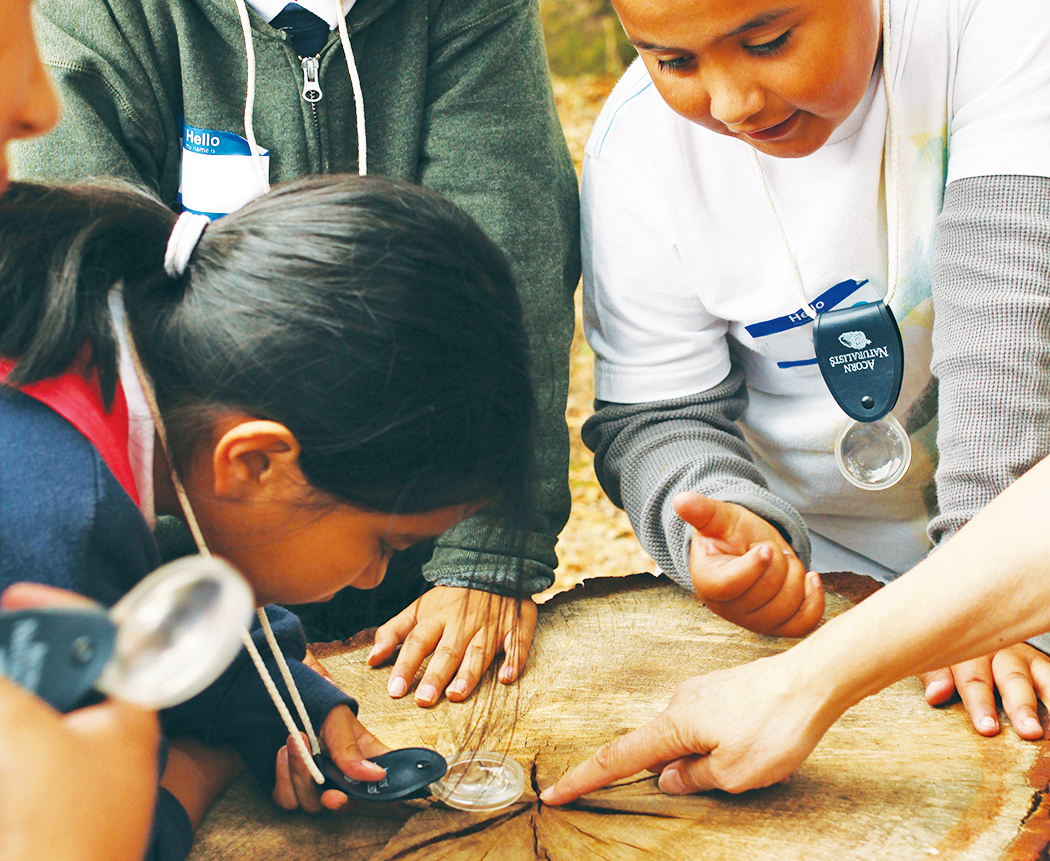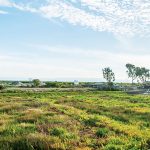
Students from San Pedro Elementary School in San Rafael enjoy a field trip to Miwok Meadows in China Camp State Park. Photo courtesy WildCare.
Kids like to be outside, and it’s good for them. Nina S. Roberts, a recreation and parks professor at San Francisco State University, said research shows that being outdoors benefits young people physically, emotionally, spiritually, and intellectually. It can improve cognitive functions; increase empathy; reduce isolation, loneliness, and stress; combat obesity; and enhance understanding in a cross-cultural world. “It’s a way to get kids more socialized by using nature as a hook,” said Roberts. “What better way to get kids to learn about each other than through the natural world?”
Many kids say they like being outside. A 2011 study of youth and nature conducted by The Nature Conservancy found that most of the young people ages 13 to 18 surveyed said being outdoors made them feel peaceful, calm, free, happy, adventurous, and alive. In addition, teachers know that being in nature can improve a student’s attention span, grades, and attendance.
If youth, scientists, and teachers agree that being outdoors is good for young people, who spend most of their time at school, why is it that fewer than one-quarter of those surveyed in The Nature Conservancy study went on a school field trip on even a monthly basis?
“Transportation is the biggest barrier that schools have to getting kids outside,” said Eileen Jones, education director for WildCare, a wildlife hospital and education center based in San Rafael. Like many environmental educators, WildCare has instituted a bus program to help teachers get kids on field trips with their organization. WildCare offers bus scholarships to schools in all nine Bay Area counties, and like other nonprofits that provide bus assistance, they base the need on the percentage of kids in a given school that qualify for free and reduced-price meals (FRPM).
Cost, administration, and the availability of vehicles and drivers are listed as the greatest challenges in a transportation report prepared by the Great Valley Center and the Stewardship Council. The report says charter buses are the most commonly used mode of transportation, and the most expensive. District yellow buses are more affordable, but they are restricted by midday use and geographic range. Remember carpools? They aren’t much of an option anymore given liability, insurance, coordination, and unknown driving records. Furthermore, both parents often work. Public transportation is viable in some areas, but it has limited destinations and can be a challenge to use as a group. SFSU’s Roberts says an under-utilized option is existing fleets of buses such as the PresidiGo Shuttle and those owned by cities and municipalities. She thinks most would be willing to work with schools.
There are several more important reasons to get youth outside. Environmental educators and conservation advocates know that outdoor experiences can lead to future stewardship of the environment. About two-thirds of the teenagers surveyed by The Nature Conservancy said they have had a personal and positive experience with nature. That 66 percent was more likely to say they were concerned about the health of the environment, more likely to think that protecting the environment was “cool,” and more likely to think that climate change can be addressed by acting now.
Creating stewards of the future is one reason that organizations provide bus support. Another is to provide equal access to open space and parks. The East Bay Regional Park District (EBRPD) serves about 60,000 school children a year at their 73 parks and 10 visitor centers, said Anne Kassebaum, the district’s chief of interpretive and recreation services. About 20 percent of those kids receive low-cost transportation with the Parks Express bus program. In 2017, EBRPD subsidized 477 buses for underserved youth in Alameda and Contra Costa counties at a cost of $390,000, she said.
EBRPD also provides support in the summer, when outings are sorely needed. A 2007 survey conducted by the Public Policy Institute of California found that 30 percent of teenagers polled did not participate in any outdoor activity that summer. In addition to EBRPD’s regular Park’n It Day Camp that charges $200 per person, the agency and partner Regional Parks Foundation spring for about 240 kids to participate in summer camps for free, including transportation. For one week, 80 kids from a school or community group chosen by the agency are bussed to various EBRPD parks where they fish at Point Pinole, pet animals at the Little Farm in Tilden, swim at Lake Anza, or canoe at the Tidewater Boating Center in Oakland.
Another organization that provides transportation support is Environmental Volunteers in Palo Alto. The nonprofit launched its Transportation Fund in 2011 with a seed grant from the Bay Area Environmental Education Funders Consortium. The Transportation Fund helps pay for buses for schools in the nine-county Bay Area that qualify based on their FRPM percentage. Any teacher from a qualifying school can apply for bus support for an outing of their choice. In the 2016-17 schoolyear, the fund helped 17,149 students get out to parks or open spaces.
Oakland’s Youth Outside has a more targeted approach. Youth Outside works to get underrepresented youth in more outdoor programs and into the environmental movement. One of their programs is the Outdoor Trips Fund, which since 2012 has helped nearly 21,000 kids go on field trips that focused on science or environmental education. The organization also addresses other barriers that contribute to deterring some youth from using the trails, including a culture of who is represented in the outdoors. The Outdoor Foundation reports that 74 percent of people who recreate outdoors are Caucasian.
All these programs are competitive. Environmental Volunteers’ Transportation Fund starts receiving applications in August, and once the available money has been promised, applicants are placed on a waiting list. As money comes in, out it goes to teachers on the list. Executive Director Elliot Wright would love to see the program funded adequately to accommodate everyone. “The last thing I want is for teachers to feel like they are competing to get their kids out to open space,” he said.
“We’re seeing change,” said SFSU’s Roberts. “Some nonprofits are [funding transportation], but others need to step up. They are the ones who have the skills to help schools out and should do more of the heavy lifting. They know the funding sources more than the teachers do.”
Grants are a good place to start. Solano Land Trust recently received a grant from the California Coastal Conservancy to help get kids to a science-based program at Rush Ranch Open Space to learn about the marsh. The organization had noticed a decline in requests from schools for field trips.
“We’ve got the Suisun Marsh, we’ve got the kids, and we’ve got the curriculum. Without the funds for buses the equation wouldn’t be complete,” said Solano Land Trust’s Michelle Dickey.
Help with transportation costs makes a big difference for schools and teachers. The EBRPD asked Parks Express participants if they would have visited the park without bus support, and 94 percent said no.
While programs that bring nature to the schools in a van are also helpful, they can’t replace a field trip to a local treasure where kids can look up at the redwoods at Muir Woods National Monument or explore the tidepools at Fitzgerald Marine Reserve. “It is in our DNA to be outside and play in nature,” said WildCare’s Jones.
Aleta George covers open space for the Monitor.
